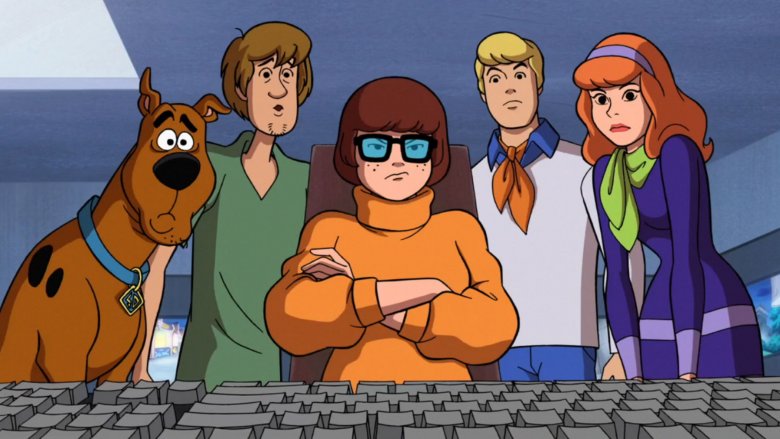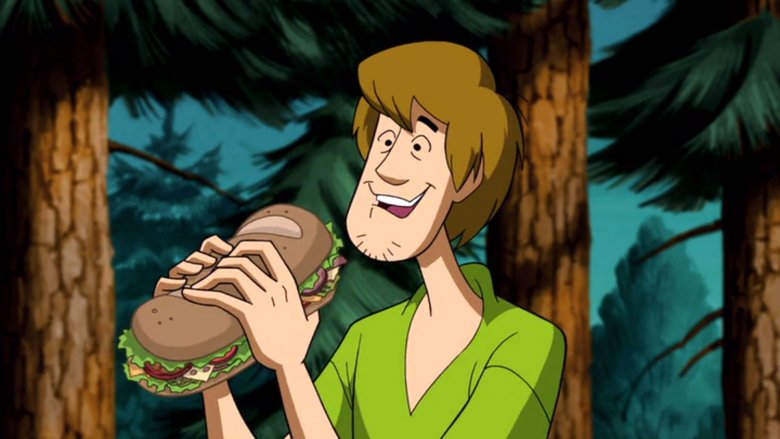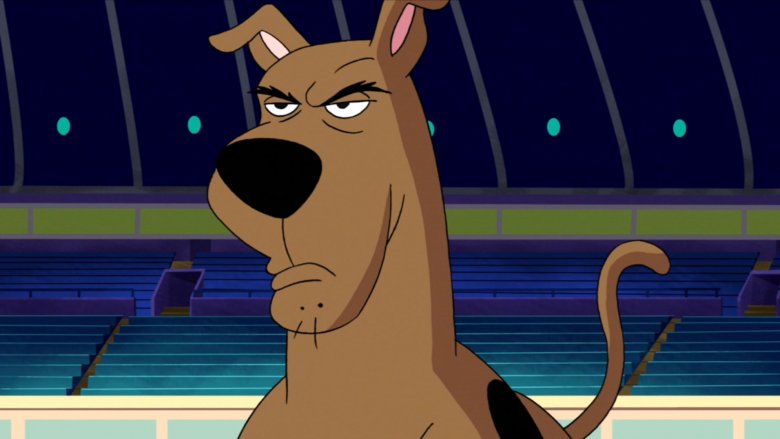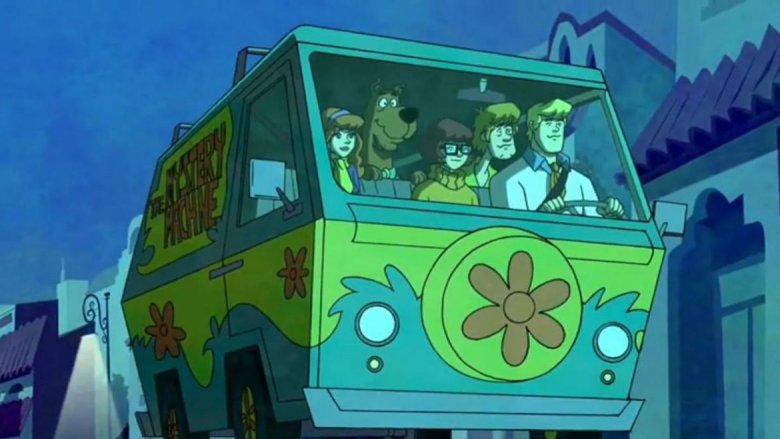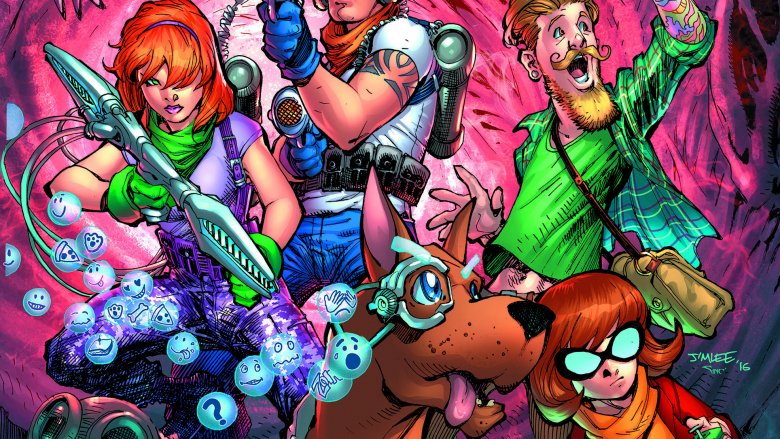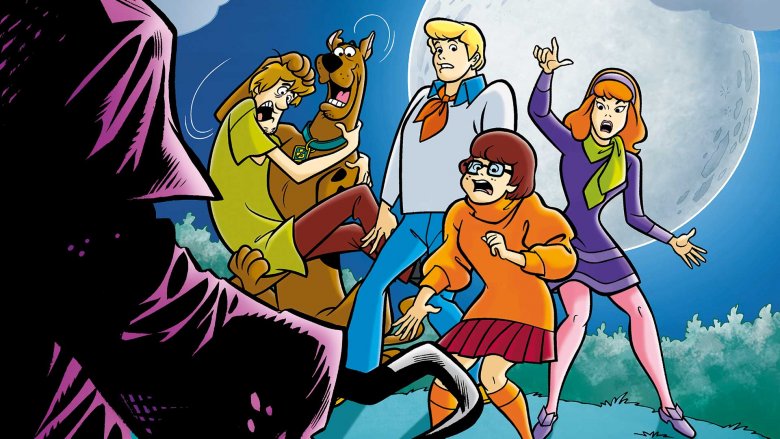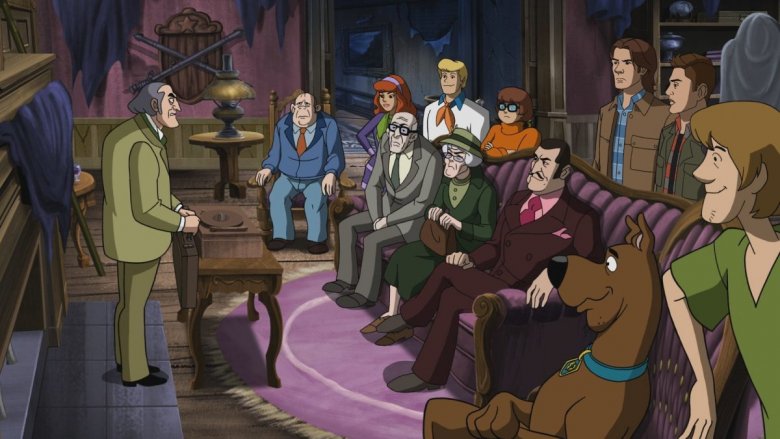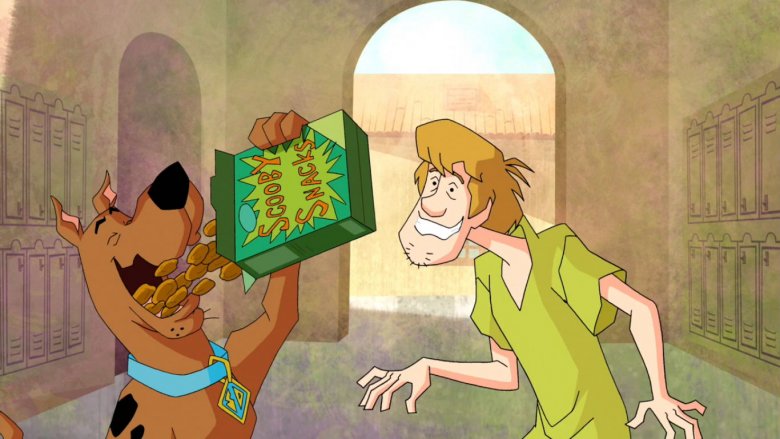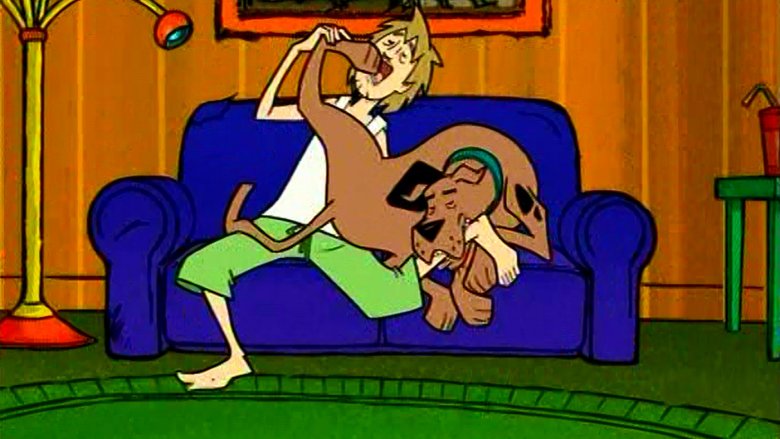Scooby-Doo Theories That Will Make You See The Characters Differently
When you look back at some of your favorite cartoons from childhood, it's easy to see things that don't make sense. Why did the Transformers from the '80s cartoon have such bad aim? Gargamel was never going to succeed at turning the Smurfs into gold; why didn't he just get a job? Why did the guys on the first Voltron cartoon always spend so much time in the separate lions rather than just forming the giant robot right away? They had to know they'd have to do it eventually.
When you're faced with the inconsistencies, you have some choices. The first and most obvious is that you can forget about it and say, "whatever, it's just a cartoon." Choice #2? You can decide the people who made the show were incompetent, lazy, or both. Or there is the time-consuming but — if you've got the right attitude — fun and rewarding path of making an absolutely insane theory about what was "really" going on in that show.
Take for example, Scooby-Doo. The story about a small group of young people driving around a country with a talking dog and solving mysteries — which pretty much always involves them proving there isn't actually a ghost but just an old jerk cosplaying — has enough nonsense in its description to warrant some intense and involved theories. From accidental wizards to Soviet Scoobies, here are Scooby-Doo theories that will make you look at the characters very differently.
Shaggy is no conjurer of cheap tricks
Fans of the theory that a close look at Star Wars: The Phantom Menace proves that Jar Jar Binks was originally meant to be a Sith Lord will be familiar with the kind of argument posted by tumblr user Eternal Phantom, who believes Scooby-Doo's goofy-but-lovable Shaggy is secretly a wizard.
Eternal Phantom posted her theory in August 2016. She points out that while, yes, Shaggy is a cartoon character, it's usually only Shaggy and his buddy Scooby who do anything you'd consider impossible or supernatural, including levitating and pulling objects (particularly food) seemingly out of nowhere. According to Phantom's seemingly exhaustive research, the first example of Shaggy doing something straight-up Gandalf-esque was in the 1976 episode "High Rise Hair Raiser" when Shags inadvertently casts a magic spell twice. Shaggy's secret Hogwart's training continues to impress in more recent Scooby-Doo fare, says Phantom, in which Shaggy seems to be the only one able to identify magical objects.
Phantom's smoking gun is the 2008 direct-to-DVD movie Scooby-Doo & The Goblin King, in which a "magical character" actually uses the word "wizard" to describe Shaggy. Whether or not Eternal Phantom's points have merit, Doctor Strange probably won't be shaking in his boots anytime soon. And whether he's a wizard or not, Shaggy seems more interested in Doritos than Dormammu anyway, so it's all good.
Dasvidanya, Scooby
There was a time in America when the former Soviet Union was blamed for just about everything. Reddit user themightyheptagon wants to add one more thing to the list — namely, Scooby-Doo.
Their surprisingly (and maybe disturbingly) well-defended theory, posted in 2016, puts forth the idea that the reason Scooby-Doo can speak English is that he was part of the real life Soviet space program that launched three dogs into space between 1957 and 1960. According to the theory, the Soviets decided it made more sense to work on developing intelligence in a dog so they could continue using canines for space exploration, rather than risking the lives of human cosmonauts. And so Scooby-Doo was born. The theory continues that Scooby escaped as a puppy to the United States with the help of a sympathetic scientist, and then presumably was willed to Shaggy after that scientist died. The theorist points out that Scooby is a Great Dane, that Great Danes are a German breed of dog, and that before the end of World War II the Germans were at the cutting edge of rocket technology.
The Soviet Scooby theory doesn't end there. It goes further, saying that offscreen the CIA learned of Scooby-Doo's existence and was in hot pursuit while he and his friends were solving mysteries. This is why the title of Scooby's first show was Scooby-Doo, Where Are You! — according to themightyheptagon, it wasn't being shouted by scared teenagers in haunted houses, but by frustrated CIA agents in surveillance vans.
Easy Riders
Reddit user themightyheptagon spends more time than you or I thinking about Scooby-Doo. A year before he posted his Soviet Scooby theory, he wrote another in-depth speculation about Scooby and his gang. This earlier post asked how these "four mismatched kids" ended up living in a van together, and points out that the show's writers never chose to reveal "where they were driving all that time."
According to this theory, the Scooby gang is most concerned with not being sent to Vietnam. All the human members of the Scooby Gang are "draft-dodgers on their way to Canada." With brief profiles for all the non-canine members of the cartoon cast, the theory explains how each of them fits — Shaggy is a Jack-Kerouac-inspired hippie and Scooby is his dog, Fred is a suburban kid whose draft number came up, Daphne is Fred's fiancée who stayed with Fred once he decided to dodge the draft, and Velma with her less feminine attire is a classic antiwar activist.
The mysteries the gang solves, says themightyheptagon, are just a "diversion" on their exodus to the Great White North. He calls Scooby-Doo, Where Are You! "a journey into the American heartland from the perspective of four disillusioned children on the 1960s."
We hadn't realized Scooby-Doo belonged in the same classification as Easy Rider. Considering how that movie ended — with both protagonists being gunned down on their motorcycles — it does make you wonder if someone finally took care of those meddling kids.
Scooby Apocalypse
There is actually a DC comic book called Scooby Apocalypse that reboots the story of the Scooby Gang in a post-apocalyptic world. But this is not the same kind of apocalypse reddit user Randomd0g was talking about in 2014.
Randomd0g theorizes that the America Scooby and his humans drive through while solving mysteries is not the same America that exists in the real world. In Scooby-Doo's alternate history, the United States has suffered an apocalyptic economic collapse. Randomd0g has three major points. First, there's the fact that almost every episode is set in a "run down hotel, an abandoned theme park, an unused airfield," suggesting that most businesses in this alternate United States are similarly crumbling ruins. Second, Randomd0g points out that the villains in Scooby-Doo are usually after money, yet they're also usually "scientists, engineers, entrepreneurs" or other people you wouldn't expect to have a tough time legally acquiring cash. Third and finally, there's Shaggy and Scooby's insane eating habits. Randomd0g says this is because Shaggy can't afford separate food for himself and Scooby, so they both eat the same food and both eat it "as if they don't know where their next meal is coming from, because they genuinely don't."
If nothing else, Randomd0g's theory does open up more crossover possibilities. Forget Batman or the Harlem Globetrotters. If Randomd0g is right, they could crossover with Viggo Mortensen and his kid from The Road or the cast of The Walking Dead. The "Scooby-Doo Meets Mad Max" episode would be weird, but we'd watch it.
South of Heaven
Perhaps the darkest theory (yes, darker than theories about Soviet lab rats) is that all the humans accompanying Scooby-Doo are dead. They're suffering for their sins in Purgatory, and Scooby-Doo is a demon watching over them. The Mystery Machine is their tomb and they can never wander too far from it lest they incite "Scooby's demonic wrath." They drive around and solve mysteries in order to atone for their sins.
More than most, the Purgatory theory takes liberties with the Scooby gang's personal info. Its uncredited writer tells us Fred was a "womanizing, bullying sociopath," Daphne is vain and uses sex to get what she wants, Velma was too interested in academics to pay attention to her friends and family, and Shaggy was a junkie who died of an overdose (and was possibly, once again, a draft dodger).
If nothing else, the Purgatory theory could explain one thing that none of the other Scooby theories seem to touch upon — why no one in the Scooby gang ever changes their clothes.
Also, the 2018 release of the "Scoobynatural" episode of Supernatural could be seen as solid proof of the Purgatory theory's merit. Supernatural's heroes Sam (Jared Padalecki) and Dean Winchester (Jensen Ackles) were transported to the animated world of Scooby-Doo in the episode. Considering how many times the brothers on Supernatural have wound up in Hell, Purgatory, Heaven, and every place in between, it's not too huge a leap to suggest Purgatory or something like it is exactly where the Winchesters found their less kill-happy colleagues.
Scooby Snacks go well with Kool-Aid
Are there people who use Reddit for something other than Scooby-Doo theories? We're pretty sure there are, but it's tough to not get tunnel vision.
In 2013, user RADDman argued that the various personalities found in Scooby-Doo, Where Are You! made up a religious cult. Fred is the charismatic leader. Daphne is Fred's "groupie," always going off alone with him during mysteries and doing whatever he says. Velma is the socially awkward teenager who has fallen in with the cult because of the more traditionally attractive Fred and Daphne, whose company helps her feel accepted. Shaggy, like the serial killer known David Berkowitz (a.k.a. the Son of Sam), believes a dog is talking to him and telling him what to do.
Perhaps the most convincing piece of RADDman's theory is that it explains why Mystery, Inc. does what it does. The reason the group is constantly solving mysteries involving ghosts or monsters, and working hard to determine whether or not they're dealing with actual supernatural creatures, is because they want to find the genuine article. Like a wizard trapping a demon and pressing it into his service, Scooby's cult wants to find a powerful supernatural beast and use it for their own weird ends.
There's a reason why Scooby and Shaggy are always hungry
Probably one of the most common theories — and the most believable — is that Shaggy and Scooby (or maybe just Shaggy because maybe there is no Scooby) are on drugs.
Perhaps the most obvious clue is the constant hunger for Scooby Snacks that the cowardly pair expresses. Some think the cravings for the snacks come from the munchies; others think the drugs are the snacks. There are cultural cues, like the psychedelically colored van and Shaggy's speech pattern and slang. And of course let's not forget the fact that Shaggy is constantly having conversations with a dog.
Some people go further and theorize that Scooby doesn't really talk at all, but that Shaggy is hallucinating Scooby's speech. Others think most of what happens in the show is nothing but a drug hallucination. Shaggy's constant paranoia is a telltale sign. Some might say considering the mysteries the gang tackles, Shaggy's paranoia is warranted, though that forgets that in just about every mystery it turns out the ghosts or monsters aren't real — yet every time without fail Shaggy is the one who thinks they are real. In fact it's usually Shaggy and Scooby who uncover the falsehood before anyone else.
The greatest characters in American literature
British actor and stand-up comic Eddie Izzard doesn't necessarily have a specific theory regarding a hidden meaning in any of Scooby-Doo's shows or movies, but according to one of his bits, Izzard believes Shaggy and Scooby are "the greatest characters in American literature." He also suggests they're the best way for traveling Americans to make friends.
In his 1998 stand-up special Dress to Kill, Izzard told his American audience that bringing up "Shaggy and Scooby" would universally elicit overjoyed responses from anyone, anywhere in the world, no matter how they felt about America or its foreign policies. He went on to explain that he felt Shaggy and Scooby were the greatest characters in American literature — going so far as to compare them to the Shakespearean character Falstaff – precisely because they were cowards and so reminded us of ourselves. He did not, however, hold similar opinions for Shaggy and Scooby's colleagues. He said something we can't repeat here about "the rest of the guys in the van" and suggested that Scrappy-Doo should be shot in the head.
Scooby-Doo on the couch
In 2011, Curtis Silver kicked off a "Psychology of Cartoons" series for Wired, and his first entry covered Scooby and his buds. Curtis diagnoses everyone in the cast, and some of what he writes supports other Scooby theories. But the most surprising thing about it is who the most sane among them turns out to be.
Fred, Silver writes, is a classic narcissist. He's vain, intolerant of criticism, doesn't listen to anyone else, and can't stand Shaggy and Scooby. Daphne suffers from Dependent Personality Disorder, stuck as a perpetual damsel in distress (though Silver points out this changed in later versions of the stories). Velma has Obsessive-Compulsive Personality Disorder, which serves her well in solving mysteries. Scooby-Doo, according to Silver, clearly has Dissociative Identity Disorder because he's a dog who "thinks he's people." Silver says the smoking gun is Scooby's extended family of "nutty dogs" who likewise think they're people.
But Silver says the sanest of the bunch is Shaggy. Silver calls him a "cowardly pothead with hints of paranoia," but says the paranoia doesn't go far enough to be considered a disorder, making him the only member of Mystery, Inc. without a personality disorder. It's a little counter-intuitive, but when you stop and think about it, it makes sense. Mystery, Inc. is constantly called upon to deal with what they are told are ghosts and monsters. Shaggy is the only human member of Mystery, Inc. who does not want anything to do with the ghosts and monsters in question. Which, yeah, seems pretty sane to us.
